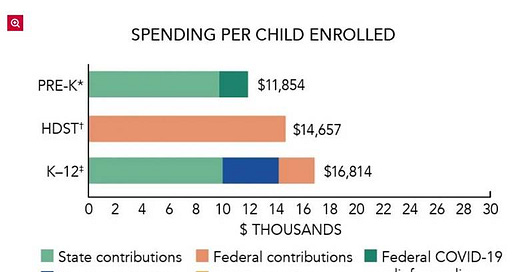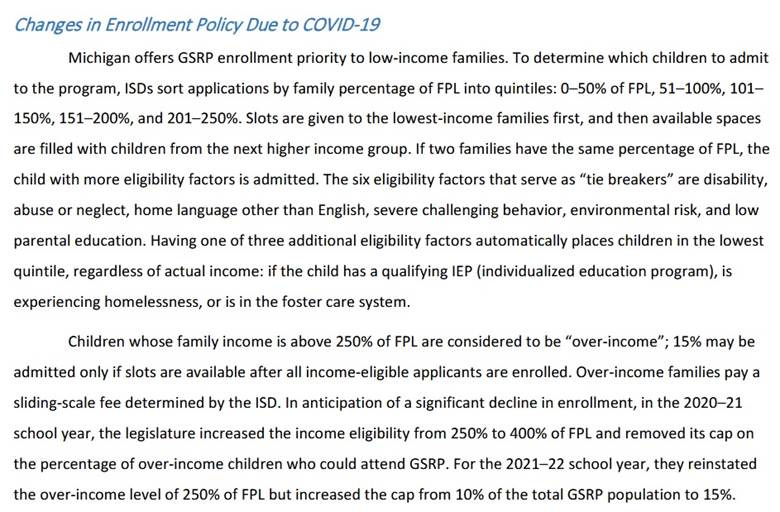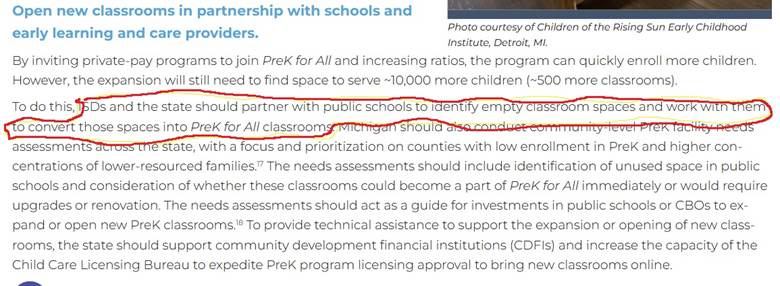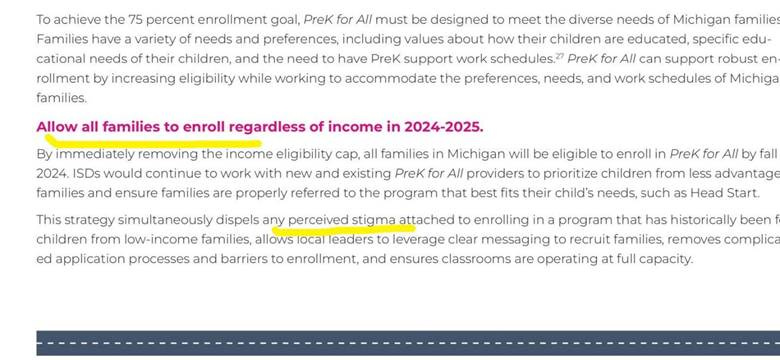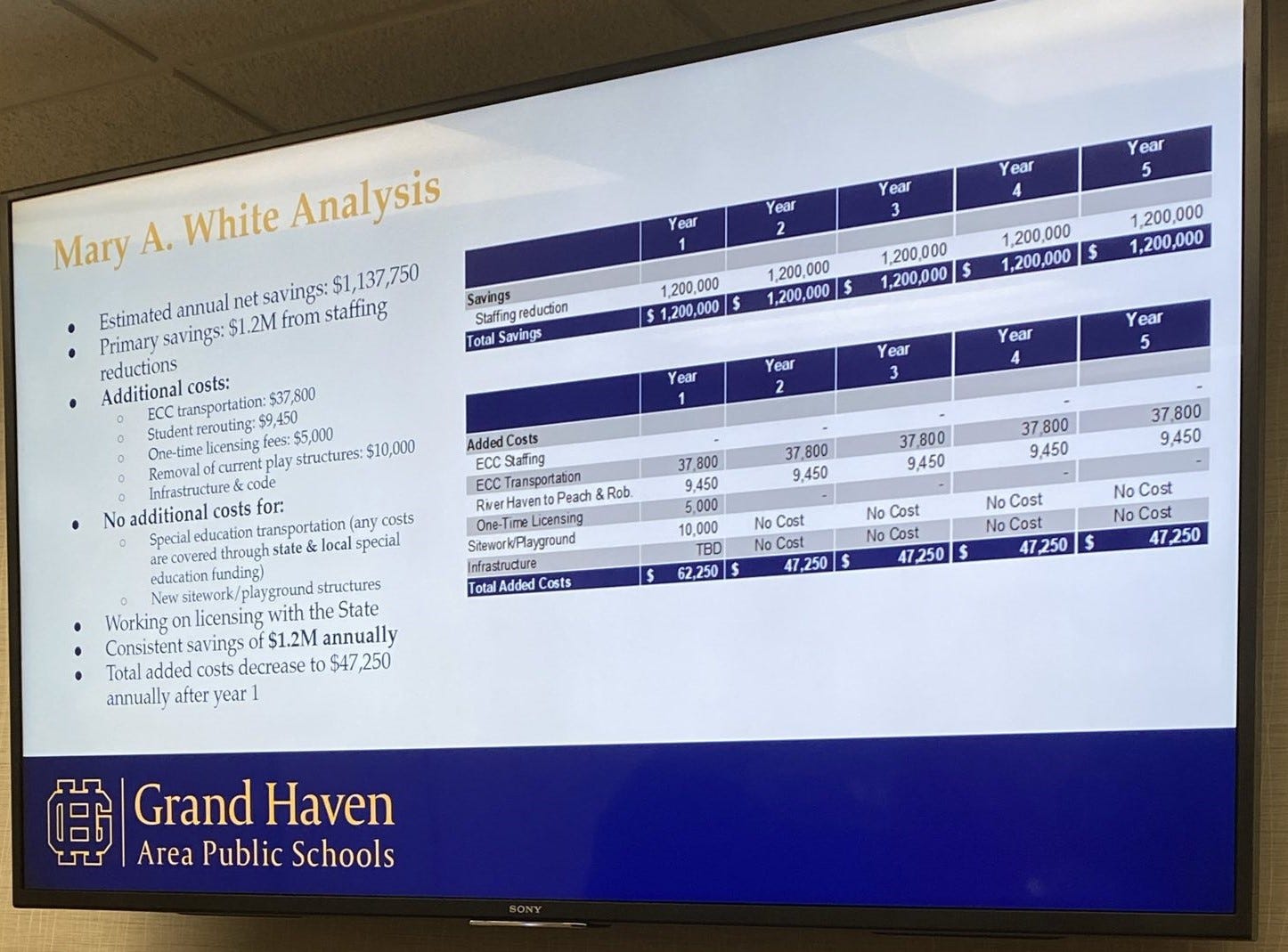Grand Haven Area Public School (GHAPS) leaders have publicly stated that the rush decision to repurpose Mary A. White Elementary School is purely a financial decision. While they point to a $5.5 million budget shortfall and frightening statements such as “if we don’t make changes, we will not be able to open our doors in two years”, we speculate that the State of Michigan is having a significant influence on this decision due to the state’s expansion of preschool funding.
During the information session, GHAPS administration said that offering a preschool program would increase district revenue, but were unsure of the amount. This is because the increase in revenue is dependent on the number of preschool students that enroll, and the state’s funding policies which are constantly changing. The following graphic is State of Michigan Great Start Readiness Program funding for 2025.
Michigan three and four-year-olds attend a variety of preschool programs, and some of those programs receive public funding. One such program, the Great Start Readiness Program (GSRP), is Michigan’s state funded preschool program for eligible students. According to the 2021-22 GSRP Annual Report, tuition is free to qualifying individuals, and “Any family over-income must pay a fee on a locally determined sliding scale unless they are homeless, in foster care, or have an IEP recommending placement in an inclusive preschool setting.” In 2021-22, over-income was capped at four-times the poverty level. In other words, any families that earned over four-times the poverty level could not send their children to GSRP. If capacity was available, once children in poverty wage-earning families were enrolled, priority was established based on factors such as language spoken at home, presence of abuse/neglect, and parental education level.
In 2022-2023, the state used $83 million in federal funding to expand GSRP, and in 2024-2025, the state massively increased GSRP’s allocation to $609 million from the state school aid fund. In July 2023 by executive order, Governor Whitmer created the Michigan Department of Lifelong Education, Advancement, and Potential (MiLEAP). MiLEAP works with “Growing Michigan Together Council to strengthen preschool to postsecondary learning while growing the state’s economy and population.” Today the MiLEAP Roadmap for Implementing PreK for All “aims to enroll 75 percent of four-year-old children, which would make Michigan the top-enrolling state in the country [] in publicly funded programs by 2027.” In fact, they are working with public schools and intermediate school districts (ISDs) to achieve their goals.
The state currently provides $25,000 grants to help open or expand GSRP preschool classrooms. Additionally, preschools can receive reimbursements from the ISD for numerous operating expenses such as curriculum and furniture. ISDs submit requests for funding to purchase curriculum, assessments, and screening tools. MiLEAP provides the ISDs with a worksheet to track curriculum funding. MiLEAP calculates ISD allocations based on the state's appropriation and the funding level per program option. ISDs then pay individual program providers. Other grants are also available.
Additionally, just as school districts receive per-pupil state funding for K-12th grade, they now receive per-pupil funding for preschool students. As of 2023 data, Michigan’s per-pupil state funding profile looks as follows:
In the past, families had to have an income-based need to attend a GSRP program, but that requirement was completely lifted in 2024-2025.
Additionally, according to Fox 25, Michigan will soon be expanding preschool for all programs to include three-year-olds which could greatly increase revenue potential for existing programs.
While this expansion of state-funded preschool may appear like a win for young families, it definitely has its drawbacks. For one, “The expansion of taxpayer-funded preschool for four-year-olds strongly incentivizes parents to leave private preschool programs.” This not only results in fewer options for parents, but works to force home-based day-care providers out of business.
During the Mary A. White information session on February 24, 2025, it became obvious that this plan has not been well thought-out. For starters, most parents are not excited about the prospect of their four-year-olds having long bus rides to preschool. A parent exclaimed, “people don’t want to drive all around the district to bring their little kids to preschool.”
Community members asked numerous questions regarding the financial analysis that went into the plan. One parent asked, “At my company if we are making operational decisions, we have the costs worked out. How can you make an operational decision if you don’t know the cost?” Despite holding a preschool enrollment event at Central Park Place on February 13, 2025, and creating a job posting for a preschool administrator on February 3rd, the district does not have an estimate of how much revenue will be generated from opening a preschool. The district disclosed that there will be unknown costs associated with licensing, playground modifications, and modification to busses, but then provided estimates of those costs during the Tuesday March 4, 2025 board Business committee meeting.
It seems the entire plan is based on the State of Michigan funding preschool programs in a similar manner to K-12th grade education. This makes the rush decision to close Mary A. White Elementary even risker as the district could have to reverse course as early as next year if the structure of state and federal funding to education changes, which is highly likely as President Trump has publicly stated that he would like to get rid of the Department of Education.
This plan will displace roughly 260 children in favor of an unknown number of preschool students who do not currently attend school. It will also likely put small business daycare providers out of business, and result in fewer childcare options for parents. The district is continuously talking about the mental health of students, yet this decision is entirely based on a financial gamble. This decision will arguably have a negative effect on the mental health of these young students and their families.
Understanding all of the financial incentives paints a clearer picture of how preschool students are being prioritized over current K-4th grade students in hopes of creating more revenue for the district. In the big picture, what started as a government program to provide preschool services to low-income 4-year-olds was expanded to include 4-year-olds in higher earning low-income families, then expanded again to include all 4-year-olds, and is now expanding once again to include 3-year-olds. Consequently, taxpayers will be footing a much bigger bill, and the expansion of state-funded preschool programs will reduce the number of private preschool programs.
GHAPS is a school district, not a preschool district. They should refocus on their primary mission rather than taking on additional responsibilities.
